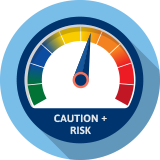February 11, 2019
L&S Risk Pulse™ Score

Caution +
The composite economic picture is mixed or unclear, indicating confusion in global markets. Valuations are questionable and volatility must be monitored.
L&S Risk Pulse™ Insights – “What a Difference a Month Makes“
General Comments
So much of the pessimism prevalent at the end of December has dissipated, and markets have responded with solid gains during the month of January.
To begin, the Fed has backed off their position that rates must rise several times in 2019. While the “dot plot” (the Fed governors forecast of interest rates) does call for some modest interest rate increases in 2019, recent comments from Fed Chair Powell suggest that the Fed is likely to be on hold for the first several months of this year, and perhaps longer. Further, the Fed has also backtracked on their comments that reductions of their balance sheet would continue on “autopilot.” While the Fed does want to see its balance sheet return to a more normal level after the huge increases undertaken during the financial crisis, they have recently suggested that a more normal level is likely to be significantly higher than previously indicated. For many investors who perceived the Fed on the cusp of a major policy mistake that could precipitate a recession, this news was a welcome relief and helps reduce the risks facing the market.
In December, there were significant concerns that slowing growth in Europe and China would lead to slower growth in the U.S. There is certainly some validity to this concern. Offsetting this concern were reports of strong gains in employment for both December and January. Over the past three months, the average number of new jobs created has been a very strong 240,000. Strong job growth does not portent a recession in the very near future.
Another fear focused on concerns that corporate profits would enter a recession even if the economy did not. Further, many investors have been worried about the potential for profit margins to peak. Corporate earnings reports have not been as dire as some had feared, and operating profit margins have actually been expanding since the recent June lows. Another worry taken off the front burner, at least for the present.
The government itself was one of the reasons confidence was declining at the end of last year. The self-inflicted government shut-down was harmful to the economy and harmful to the perception that leaders from either party could actually provide leadership. Thankfully, the government shut-down ended following the realization that air traffic control workers were not showing up to work without pay at an alarming rate. While the threat of another shutdown looms, we do not think either party wishes a repeat of the senseless pain inflicted on government workers solely for political gain.
Credit spreads, the premium charged to lower quality borrowers, had been rising throughout most of 2018, and had reached multi-year highs as the year ended. This raised questions of whether companies would be able to refinance their debts, or whether credit would be available for investment in projects that could lead to future growth and profitability. Here too, concerns have reduced. Credit costs have declined, and worries about a liquidity crisis have proven to be without merit.
Finally, markets continued to be troubled by concerns that trade tariffs would likely be a policy mistake. While no formal resolution has been reached, the perception is that both China and the U.S. would benefit from a reduction in hostilities, and investors have grown more optimistic that some kind of resolution will be reached.
Slowly and surely nearly all the fears and concerns that were plaguing markets seemed to dissipate, and markets were able to recapture some of the severe losses suffered in the fourth quarter, and particularly in December.
Conclusion
Risks that weighed heavily on financial markets last year seem to have diminished, and stock prices responded by recouping some of the losses suffered in the fourth quarter. That poses two problems for us: First, it is unlikely that we will see a repeat of such a dramatic reduction in perceived risks. That begs the question of what will continue to drive stock prices higher from here? Second, what happens if some of these risks come back to the foreground? Trade, as we mentioned, is not settled. Growth in China remains weak, and growth in Europe continues to disappoint. Will slower global growth drag the U.S. down with it? Will there be meaningful conclusions from the Mueller investigation that damage the Presidency? It does seem as though risks are still apparent, even if they are less threatening than they were at the end of 2018.
We continue to believe that the current environment is more favorable than it was in the fourth quarter of last year, but the situation is not without its risks. We remain vigilant to changes in the data points that help us determine when those risks pose a threat to investors.
